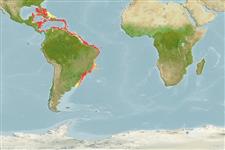Elasmobranchii (sharks and rays) >
Carcharhiniformes (Ground sharks) >
Carcharhinidae (Requiem sharks)
Etymology: Rhizoprionodon: rhiza (Gr.), root; prion (Gr.) saw; odon (Gr.), tooth, referring to teeth with serrated (saw-like) bases, or roots [replacement name for Rhizoprion Ogilby 1915, preoccupied by Rhizoprion Jourdan 1861 in mammals]. (See ETYFish); porosus: Latin for pored or full of holes, referring to enlarged hyomandibular pores on both sides of head. (See ETYFish).
More on author: Poey.
Environment: milieu / climate zone / depth range / distribution range
Ecology
Marine; freshwater; brackish; reef-associated; depth range ? - 500 m (Ref. 244), usually ? - 100 m (Ref. 244). Tropical; 28°N - 40°S, 88°W - 32°W (Ref. 55194)
Western Atlantic: Caribbean, including the Bahamas, south to Uruguay. The separation of this species from Rhizoprionodon terraenovae whether as a distinct species or a representative of a southern subspecies is still uncertain and pending until detailed studies are commenced.
Length at first maturity / Size / Weight / Age
Maturity: Lm 65.0, range 80 - ? cm
Max length : 113 cm TL male/unsexed; (Ref. 111958); common length : 75.0 cm TL male/unsexed; (Ref. 5217); max. published weight: 7.5 kg (Ref. 111958)
Common in bays and estuaries often entering rivers. Also found in offshore waters at depths of about 500 m, generally less than 100 m. Feeds mainly on small bony fishes, including wrasses, but also marine snails, squid and shrimp. Viviparous, with 2 to 6 young in a litter. Size at birth about 31 to 39 cm. Utilized salted or frozen for human consumption and processed into fish meal. Not dangerous (Ref. 9710).
Distinct pairing with embrace (Ref. 205). Viviparous, placental (Ref. 50449).
Compagno, L.J.V., 1984. FAO Species Catalogue. Vol. 4. Sharks of the world. An annotated and illustrated catalogue of shark species known to date. Part 2 - Carcharhiniformes. FAO Fish. Synop. 125(4/2):251-655. Rome: FAO. (Ref. 244)
IUCN Red List Status (Ref. 130435)
Threat to humans
Harmless
Human uses
Fisheries: commercial
More information
ReferencesAquacultureAquaculture profileStrainsGeneticsElectrophoresesHeritabilityDiseasesProcessingNutrientsMass conversion
Tools
Special reports
Download XML
Internet sources
Estimates based on models
Preferred temperature (Ref.
123201): 17.5 - 27.1, mean 24.2 °C (based on 80 cells).
Phylogenetic diversity index (Ref.
82804): PD
50 = 0.5078 [Uniqueness, from 0.5 = low to 2.0 = high].
Bayesian length-weight: a=0.00214 (0.00141 - 0.00323), b=3.09 (2.97 - 3.21), in cm total length, based on LWR estimates for this species & Genus-body shape (Ref.
93245).
Trophic level (Ref.
69278): 4.0 ±0.2 se; based on diet studies.
Generation time: 3.7 ( na - na) years. Estimated as median ln(3)/K based on 2
growth studies.
Resilience (Ref.
120179): Very Low, minimum population doubling time more than 14 years (Fec=2; K=0.3-0.42).
Fishing Vulnerability (Ref.
59153): Moderate to high vulnerability (51 of 100).
Nutrients (Ref.
124155): Calcium = 8.95 [1.65, 47.15] mg/100g; Iron = 0.433 [0.104, 1.231] mg/100g; Protein = 22.2 [19.3, 24.6] %; Omega3 = 0.143 [0.058, 0.338] g/100g; Selenium = 38 [11, 110] μg/100g; VitaminA = 58.9 [20.5, 179.1] μg/100g; Zinc = 0.758 [0.366, 1.514] mg/100g (wet weight);
